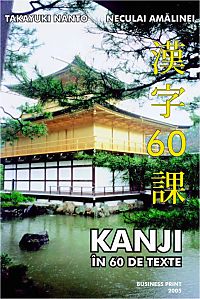 Japanese Language online course. Japanese Language online course.
For information please email us or complete the form in the contact page.
|
|
 |
| |
 Kanji in 60 texts Kanji in 60 texts
• Japanese writing,
• Texts in Japanese language,
• SKIP Method for Kanji Indexing.
Authors: Takayuki Nanto, Neculai Amalinei
Business Print Publishing House, Iasi, 2005.
224 pages, 160x235 mm
ISBN: 973-9476-44-9
Price: 170.000 lei / 17 lei noi
Available: Yes
:: Order online ::
|
 |
The Japanese spoken language and the study of Chinese characters used in Japanese writing style, kanji, are the new issues of this work.
The system of writing in the Japanese language, methods of transliteration, general rules for reading, historical background and linguistic imports of kanji in Japan, structures of Chinese characters, standards for kanji, the SKIP method for kanji indexing, etc., are exposed in an interesting and accessible manner.
Kanji in 60 texts may be used both as a guide for conversation and for the preparation of Japanese Language Proficiency Tests (JLPT).
Foreword
This book is addressed both to the people involved in the study of Japanese language and to those who are interested in the study of other foreign language that is totally different of their own.
Kanji în 60 texts continues naturally the books Japanese Language. Simply and Efficiently and Konnichi wa. Practical Course of Japanese Language published by Polirom and A 92 Publishing House of Iasi, Rumania.
The Japanese spoken language and the study of Chinese characters used in Japanese writing style, kanji, are the new issues of this work.
The texts written by Takayuki Nanto render a Japanese language full of rhythm and life. A gifted and sensible writer, he catches the spontaneity and expressiveness of his mother tongue.
The introduction of the reader in the world of kanji is accomplished by a continuous and asymptotically approach of two reference masterpieces: the dictionary The Kodansha Kanji Learner’s Dictionary, author Jack Halpern and CJKV Information Processing, written by Ken Lunde.
In this way, the book Kanji in 60 texts may be used both as a guide for conversation and for the preparation of Japanese Language Proficiency Tests (JLPT).
This work has three parts, each of them with a definite structure.
The fist part deals with the system of writing in Japanese language. The information regarding: kana syllabaries, methods of transliteration, general rules for reading, historical background and linguistic imports of kanji in Japan, structures of Chinese characters, standards for kanji, etc., are exposed in an interesting and accessible manner. Also, the System of Kanji Indexing with Patterns (SKIP), developed and patented by Jack Halpern, is introduced for the first time in Rumania.
In the second part are included 60 texts of Japanese language in which 240 kanji are explained. The specific way of kanji reading is rendered within appropriate examples. Other kanji that are different of those presented in the book, are explicitly written with furigana that offers a cursive reading in Japanese.
The texts are agreeable and expressive. They are written with both Latin andJapanese characters. Every sentence written in Japanese is accompanied by its corresponding translation into Rumanian.
In the third part are presented illustrated kanji, in order to introduce the reader into the artistic and aesthetic dimension of Japanese ideographs.
Two indexes are included too, the first for Japanese words (about 1000 entries) and the second for kanji (in the latter every kanji is presented with the On/kun reading entries and the page where it can be found).
An appendix, in which are presented 1945 kanji, Jöyö Kanji, used in Japan for public documents and the 214 traditional radicals with their variants, accomplishes the work.
Kanji in 60 texts continues our effort in approaching the linguistic expression of an ancient culture. It is impossible to walk alone on this way.
The author expresses his deepest gratitude to:
- Professor James Breen, Monash University, Australia, compiler of KANJIDICT and EDICT electronic dictionary databases, for his continuos support in transposing the creative ideas regarding the language, history and civilization of Japan;
- Mr. Jack Halpern, for the universalness of his linguistic discourse;
- Dr. Ken Lunde, Senior Computer Scientist, CJKV Type Development, Adobe Systems Incorporated, for the guideline ideas of this book and the logistic related with Japanese fonts;
- Mr. Takayuki Nanto for the excellent way of cooperation and communication in editing this book;
- Japanese associated lectures for the study of Japanese Language and Civilization in Rumania, for their huge effort and their devotion in expressing the Japanese cultural message;
- Mrs. Irina Apostoloiu for the understanding, talent and sensitivity in kanji illustrating.
The cultural message of the book is focussed to make an approach of an exotic and unique language in its complexity, which will welcome the reader with warmth and tenderness.
Neculai Amãlinei
|
|
|